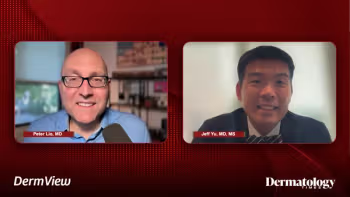
PPAR lipid improves photoaged skin appearance
New Orleans — A new peroxisome proliferator-activated receptor (PPAR) lipid has demonstrated the ability to improve photoaged skin both in vitro and in vivo.
New Orleans - A new peroxisome proliferator-activated receptor (PPAR) lipid has demonstrated the ability to improve photoaged skin both in vitro and in vivo.
PPAR lipid ingredients previously had shown efficacy in reducing UVB-induced inflammation.
"We tested several PPAR lipids in vitro and saw increased expression of epidermal differentiation proteins, which also are known in the literature as indicators of improvement in skin condition and overall skin health."
In particular, researchers examined the impact of PPAR lipids on transglutaminase (TGase), involucrin and profilaggrin compared to both vehicle and retinol controls in vitro.
"They performed significantly better than the vehicle and comparable to the retinol," Dr. Hawkins tells Dermatology Times.
One test involved treating normal human keratinocytes with a vehicle control or various concentrations of cosmetic PPAR lipid for four days. Researchers then permeabilized cells and analyzed them for TGase and cornified cell envelope (CE) maturation. They found that while a concentration of 0.01 µM performed only slightly better than did the vehicle, a concentration of 10 µM achieved three times as much TGase activity as did the control. Additionally, both 1 µM and 10 µM concentrations produced approximately twice the CE formation compared to the vehicle.
To examine in vitro decorin and procollagen I synthesis, researchers treated human dermal fibroblasts with vehicle or PPAR lipid for 24 hours. They then analyzed decorin and procollagen I expression by immuno-dot blot and found that different PPAR lipids achieved a range of approximately 1.3 times to 1.7 times the vehicle's decorin synthesis (retinoic acid achieved approximately 1.4 times versus vehicle).
Improvement without irritation
In a three-week repeat patch test study of 20 subjects with moderate to severe photodamage on the outer forearm, researchers used immunohistochemical and semiquantitative image analyses and found a statistically significant difference for involucrin expression in PPAR-treated skin versus vehicle-treated skin.
Additionally, this increased expression of involucrin did not result in a corresponding increase in erythemal evaluation. This suggests that cosmetic PPAR lipids promote CE maturation, without increasing erythema.
In separate testing of Unilever's PPAR lipid creams on photo-aged facial and arm skin, the lipids achieved similar benefits to retinols and alpha hydroxy acids (AHAs). These studies ranged between 12 weeks and 25 weeks.
"We saw significant improvement over a vehicle control in vivo. We also looked at a combination of PPAR lipid with AHAs and saw significant benefits with the combination over AHAs alone," Dr. Hawkins says.
The arm studies involved two groups of 25 patients. In the face study, there were approximately 65 subjects per group. Test subjects received moisturizer creams containing either PPAR lipid with glycolic acid, glycolic acid alone or vehicle control. Subjects applied 0.5 g to 1.0 g of their assigned product to the entire face twice daily.
Compared with the vehicle formulation, the formulation containing the PPAR lipid alone, used twice daily, resulted in a significant improvement by reduction of crepey appearance of moderately photodamaged skin on the arm. Researchers also observed improvements in parameters such as dryness and skin tone.
Combined effect greater
Perhaps more importantly, the combination of PPAR lipid and glycolic acid treatment resulted in a benefit greater than glycolic acid cream alone. The combination of PPAR and glycolic acid moreover provided a robust reduction of facial wrinkles compared with vehicle, with benefits appearing as early as eight weeks and achieving statistical significance by weeks 20 and 24.
"After seeing the anti-inflammatory properties of PPAR in the literature," Dr. Hawkins says, "we also wanted to look at the irritation profile to see if it would also have benefits in that area. We found that it didn't cause irritation, which is different from most effective antiaging ingredients (e.g. AHAs and retinol)."
Newsletter
Like what you’re reading? Subscribe to Dermatology Times for weekly updates on therapies, innovations, and real-world practice tips.


















